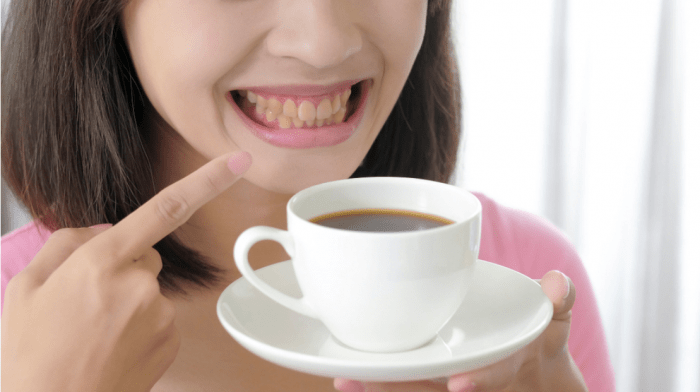Know About Top 8 Things That Makes Your Teeth Yellow

We associate light teeth with a young and healthy mouth. Discover everything that can yellow them and how you can preserve their natural tone for longer.
1. Drinking acidic drinks with a straw
Some drinks have a very acidic pH. And when this value is below 7, they erode and attack the enamel.
- When that enamel is eroded, the pigments find it easier to infiltrate the tooth’s interior, as explained by Juan J. Segura, professor at the Faculty of Dentistry at the University of Seville.
- Be careful with these drinks. The carbonated ones have a pH of 3 or 3.5, so they damage the enamel a lot. The pH of orange or lemon juice is also a little below 4, so it is quite acidic and attacks tooth enamel. Reduce your consumption.
- And if you drink them … You should use a straw and don’t brush your teeth right after drinking them. It is better to wait at least 15 minutes because if you brush them when the acid is on them, you “drag” their enamel more.
2. Coffee, best cut with milk
Some researchers present it as one of the foods with the highest pigmenting capacity.
- Moderation. Do not consume it in large quantities if you want to avoid the residues left by its tannins on your teeth. And rinse your mouth after drinking it.
- Serve it cut with milk. According to a study published in the International Journal of Dental Hygiene, casein, the main protein in milk, appears to bind to tannins and prevent staining, thereby acting, according to the researchers, with a “whitening” effect.
3. This is how dark sauces influence
Tomato, soy, ketchup, and even balsamic vinegar can darken teeth.
- It would be temporary, but don’t let more than an hour pass to wash them well.
4. Avoid dangerous purple
Tannins are very interesting polyphenols for health, but they tend to bind to the film that forms on the enamel surface. As a result, your stains do not go away with simple brushing, and you have to resort to professional cleaning, with ultrasounds to remove them.
- Red fruit. Blueberries, blackberries, cherries, raspberries, grapes, pomegranates … Their tannins are potent, so do not abuse them, and brush your teeth well after eating them.
- Red wine. Stains the margins of the teeth with a slight purple hue. It is better to avoid it.
- Beet. A recent study from the University of Zagreb (Croatia) found that patients with black spots on their teeth used to eat more beets.
5. White wine … drink it with water
If you drink wine, then drink a glass of water to clean. White does not stain like red, but its acid dissolves the enamel and, by making it more porous, makes the pigments that later come into contact with it adhere more firmly.
- After a dinner in which white wine has been drunk, drunk Coffee, for example, stains the tooth more than drunk alone. This is what a study by the University of New York (USA) concluded.
- Sommeliers, who taste many wines and leave them in their mouths for a long time, have this problem of enamel erosion, explains Professor Segura.
6. Green color can also color
Brush your teeth thoroughly after eating these foods to wash away their surface pigments.
- Green tea. Its tannins, especially in the darker varieties, stain the enamel.
- Spinach and artichokes as also associated with the color of teeth.
7. Do not abuse red or yellow spices
Saffron, turmeric, curry, paprika… are spices that, from the outset, stain your teeth a very raised yellow or red, but don’t be scared because they don’t adhere to the enamel explains Dr. Joshipura.
- If you maintain healthy hygiene and do not abuse them, they should not stay fixed and are removed with brushing.
8. Watch out for artificial colors
Gummies and candies (especially cola ones) also sometimes contain dyes that stain the tongue and teeth. However, its effect is equally transitory, and it is enough to brush well and make sure that its consumption is not excessive.
- The key is to brush your teeth 3 times a day and get 1-2 cleanings a year. There will be no stain to resist!
WHAT DOES THE NATURAL COLOR OF YOUR TEETH DEPEND ON?
Each person, given their genetics, has a specific color of teeth and skin or hair. If they have darkened, try to recover some tone.
- Point. It is considered that our teeth have a reddish or brown touch, but there may be Spaniards who have them somewhat yellow or gray, given the tremendous genetic diversity that has resulted from our racial mix.
- In young people, yellow teeth can indicate some diseases, such as liver, metabolic, or endocrine disorders. Sometimes they also signal hemolytic anemia.
- If you were given antibiotics called tetracyclines between the ages of 3 and 12 or were taken by your mother when she was pregnant, your teeth will likely have yellow, gray, or brown spots as well.
WHY DO THEY TURN YELLOW?
Over the years, teeth tend to yellow, according to Dr. Joshipura, and it occurs for three reasons:
- Translucent enamel wears down to reveal yellow to gray dentin.
- Dentin becomes thicker and more opaque as time passes.
Anything that stains a white shirt will stain your teeth
- Some pigments adhere to the teeth and stain them. They do it temporarily, but sometimes they lead to stains or colorations that are deeper and difficult to remove.







